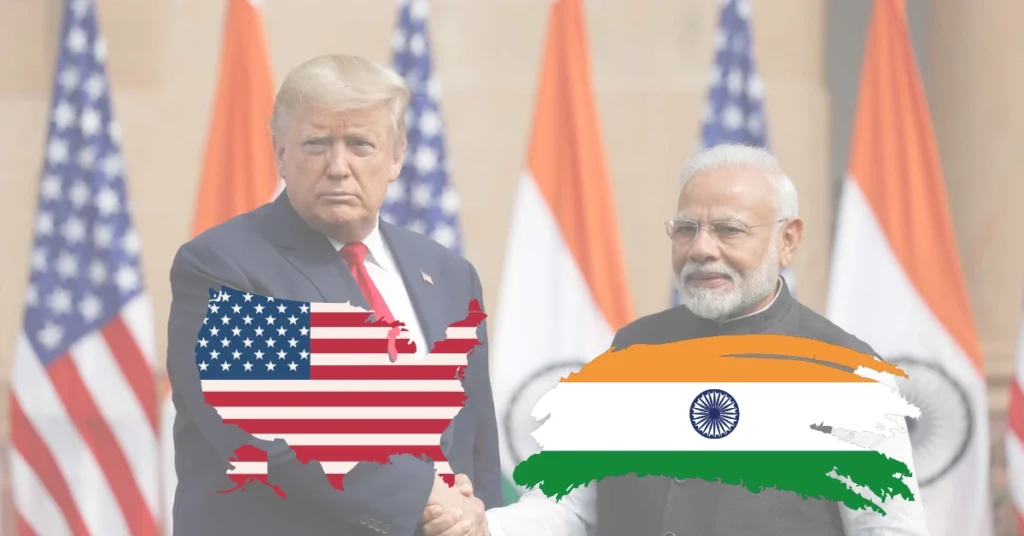With Donald Trump potentially returning to the White House, the landscape of India-U.S. relations could be set for significant changes.
Trump’s previous tenure and campaign promises indicate both opportunities and challenges for India, touching on areas from trade to defense to immigration.
Here’s an analysis of what a Trump 2.0 presidency might mean for India, with a focus on long-term effects, opportunities, and risks.
A New Chapter in India-U.S. Relations?
India and the U.S. share deep economic, strategic, and cultural ties that have weathered changes across presidencies.
Under Trump’s possible second term, certain areas of collaboration could strengthen, while others may encounter friction.
- Enduring Bonds: External Affairs Minister S. Jaishankar recently reassured that India-U.S. relations are resilient and are “on steady tracks.” India’s partnership with the U.S. has historically survived shifts in leadership, and there’s optimism that the bond could continue to thrive.
- Potential Impact Areas: Immigration, defense, technology, and trade stand out as key domains where Trump’s policies may influence bilateral relations. The emphasis on “America First” might bring a complex mix of isolationist tendencies and strong diplomatic ties that could benefit India in some areas but challenge it in others.
Key Opportunities for India
If Trump resumes office, certain developments could create unique opportunities for India, especially in trade, supply chains, and geopolitics.
- Strengthened Trade Partnership and Manufacturing:
- Trump’s stance on reducing dependency on China presents India with a prime opportunity to position itself as a manufacturing hub, particularly in sectors like electronics and pharmaceuticals.
- The “China Plus One” strategy, where global companies seek alternatives to China, aligns with India’s growing appeal as a destination for investment and supply chain relocation.
- Geopolitical Leverage Against China:
- Trump has been outspoken in his opposition to China’s economic dominance. For India, this may translate into closer strategic alignment with the U.S. on counterbalancing China’s influence in Asia.
- Key initiatives, like the QUAD alliance with the U.S., Japan, and Australia, could see renewed support, enhancing India’s position as a strategic partner in the Indo-Pacific.
- Economic Resilience Amid Shifts:
- Reports suggest that the effects of Trump’s policies on global growth may have limited impact on India, given its largely domestic demand-driven economy. This resiliency, combined with lower commodity prices, could boost India’s macroeconomic stability.
- Defense and Military Collaboration:
- India-U.S. defense collaboration has been a strong pillar of bilateral relations. Recent agreements like the GE-HAL jet engine deal could be further bolstered, with an increased focus on technology transfers and defense capabilities.
- Trump’s potential focus on counterterrorism may align with India’s regional security interests, particularly in countering terrorism threats.
Possible Challenges: Trade, Immigration, and Diplomacy
While Trump’s presidency may bring certain strategic benefits, India could face hurdles in other areas.
- Trade Tensions and Protectionism:
- Trump’s known skepticism toward trade imbalances might lead to scrutiny over India’s trade surplus with the U.S. There could be an increase in tariffs on Indian exports, potentially affecting sectors like IT, pharmaceuticals, and textiles.
- However, India’s inclusion in the “China Plus One” strategy could mitigate these impacts as American firms seek alternatives to Chinese suppliers.
- Immigration and H-1B Visa Policies:
- Trump’s previous stance on immigration reform and H-1B visa restrictions impacted Indian tech professionals working in the U.S. A renewed push for stricter visa policies could pose challenges for Indian workers and IT firms relying on skilled professionals in the U.S.
- This could lead to a slowdown in Indian tech companies’ operations abroad and impact skilled labor mobility, essential for India’s IT-driven growth.
- Diplomatic Shifts and Unpredictability:
- Trump’s approach to foreign policy has been characterized by unpredictability, and there are concerns that his policies may disrupt traditional alliances and agreements. India, however, has demonstrated adaptability in navigating both Democrat and Republican administrations.
- Despite Trump’s rapport with Prime Minister Modi, there may be less emphasis on human rights and democratic values, potentially affecting diplomatic dynamics.
What Analysts Are Saying: A Mixed Forecast
While Trump’s return could present immediate economic and strategic benefits for India, experts advise caution due to the potential unpredictability in policy implementation. Some analysts note that:
- Geopolitical Stability: Trump’s softened stance toward Russia may benefit India, which has a longstanding relationship with Moscow. Reduced U.S. criticism of India’s Russia ties could ease diplomatic tensions.
- Supply Chain Growth: India remains at the forefront of supply chain shifts from China. With a diversified funding base from the U.S., Europe, and developed Asian nations, India is less susceptible to retaliatory U.S. actions against China, compared to some ASEAN countries.
Key Takeaways
- Trade Benefits with Challenges: Trump’s trade policies may bring friction due to tariffs but could simultaneously allow India to capitalize on supply chain shifts from China.
- Immigration Roadblocks: Restrictive immigration policies could affect Indian tech professionals, though opportunities for growth in the domestic tech sector could balance this out.
- Defense and Strategic Alliances: Defense collaborations are likely to thrive, potentially positioning India as a stronger regional power in the Indo-Pacific.
- Economic Resilience: India’s domestic demand-driven economy may help it weather U.S.-centric trade shocks.
Final Thoughts
A Trump 2.0 presidency could bring both optimism and caution to India. By leveraging opportunities and managing potential risks, India can strengthen its global standing and deepen ties with the U.S.
As the world watches, India’s policymakers may focus on a balanced approach that maximizes strategic gains while preparing for potential shifts in U.S. foreign and economic policy.
sources:- indianexpress[1], zeenews[2], economictimes[3].
Also, Read | Major Financial Changes Coming in November 2024: What You Need to Know



